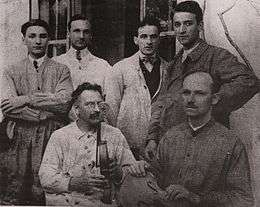Igino Sderci

Igino (Iginius) Sderci (1884 - 1983) was born in Florence, Italy. He devoted his entire career to violin making, studying under master maker Leandro Bisiach. A very prolific maker making more than 700 instruments including many large violas. He won gold medals at the prestigious Stradivarius Exhibition at Cremona in 1937 marking the bicentanary of Stradivari's death (as well as prizes in 1949).
From his earliest childhood Igino Sderci was interested in music & art. He studied sculpture in Siena and had a gift for wood carving. He made his first violin without supervision. In Siena Sderci was taken under the wing of Leandro Bisiach, who valued the young man's skills highly. In 1917 he went to Milan and worked in the workshop of Leandro Bisiach.[1] Under his guidance he refined his skills and worked with Leandro Bisiach for about 14 years before leaving for Florence to establish his own workshop. Igino Sderci copied the models of Stradivarius and Guarneri and reflected their influence as his instruments are full of character and made with utmost care. Without exception he used wood of the highest quality and fine varnish mainly of an amber-yellow shade.[2]
References
 |
| Part of a series on |
| Fiddle and Violin |
|---|
| Basic physics |
| Fiddlers |
| History of the violin |
| Luthiers |
| Musical styles |
| Violin technique |
| Violin construction |
| Violin family |
| Violinists |
- Italian & French Violin Makers by Jost Thoene 2006
- Dictionary of 20th Century Italian Violin Makers - Marlin Brinser 1978
- I Maestri Del Novecento - Carlo Vettori
- Dictionary of 20th Century Italian Violin Makers - Marlin Brinser 1978
- Universel del Luthiers - Rene Vannes 1951,1972, 1985 (vol.3)
- Universal Dictionary of Violin & Bow Makers - William Henley 1970
- Liuteria Parmense
Instruments
"The internal structure of his instruments reveal the choice of red willow for the lining and the corner blocks. The carved technique of the lining and the incision where these meet the corner blocks are always perfect. The f-holes and scroll are perfectly cut and the spiral line of the scroll is always precise." - 'I Maestri Del Novecento' - Carlo Vettori
Below is a fine example of this masters work. A very beautiful instrument made as a copy of Andrea Guarneri in 1924 label reads: "Iginius Sderci fece Siena l'anno 1924"
-

Igino Sderci violin top 1924
-

Igino Sderci violin back 1924
-

Igino Sderci violin scroll 1924
External sources
Bisiach Family Heritage. by Philip J. Kass[3][4]
- ↑ Philip J. Kass (1983). "Bisiach Family" (PDF). William Moening & Sons Ltd. Retrieved 2007-04-05.
- ↑ Liuteria Parmense
- ↑ Philip J. Kass (1983). "Bisiach Family" (PDF). William Moening & Sons Ltd. Retrieved 2007-04-05.
- ↑ Philip J. Kass (1982). "Selected World of Strings Newsletters". William Moening & Sons Ltd. Retrieved 2007-04-05.
Quotes
World Record Auction price October, 2007 Tarisio Auctions US$ 35,100 - tarisio
Igino Sderci has been called "one of Italy's very best makers. Excellent tone qualities." (Dictionary of 20th Century Italian Violin Makers - Marlin Brinser 1978).
"As is known, after the death of the last great Cremonese Masters after the middle of the 18th century, only the Cerutis remained in Cremona to prevent that memorable tradition from dying out completely. It was the Antoniazzis who undertook the task of transferring the scant knowledge saved from oblivion from Cremona to Milan.
However the most important event for the renaissance of violin-making in Lombardy was certainly the meeting between Riccardo Antoniazzi and Leandro Bisiach; the latter, thanks to his talent, his taste and his business ability succeeded in founding, at the end of the 19th century, a workshop which soon gained international fame. Bisiach was an outstanding figure in the commerce of antique violins but above all had the merit of raising a generation of great luthiers, among whom for example Sderci, Pietro Borghi, Giuseppe Ornati and Ferdinando Garimberti come to mind." - Liuteria Parmense